Home » Your Local Area » Bega Valley
Local Profile for Bega Valley Shire Council
Bega Valley Local Government Area
Hazard Exposure Summary
Climate Change Data Summary
Risk Exposure Summary
Reference
Located in south-east New South Wales (NSW), Bega Valley Shire Council is the largest coastal Local Government Area (LGA) in the state covering an area of 6,280 square kilometres. It is approximately 400km south of Sydney, 200km south-west of Canberra and directly abuts the Victorian border on the LGA’s southern extremity.
Council acknowledges people of the Yuin-Monaro nations as the traditional custodians of the lands and waters of Bega Valley Shire. Their traditional country extends from Cape Howe to the Shoalhaven River in NSW. There are various sites of aboriginal cultural heritage significance throughout the Shire demonstrating occupation to be in excess of +7,000 years.¹ Bega is thought to be named from an Aboriginal word meaning ‘big camping ground’.
Although the LGA covers a vast area, the landscape is predominantly National Park, Public Reserve and State Forest.
The township of Bega is the regional centre for the Shire. The townships of Merimbula and Berrambool, Mirador and Tura Beach is considered to be a coastal regional centre. The Shire is also supported by a series of smaller townships and villages including Bemboka, Bermagui, Candelo, Cobargo, Eden, Merimbula, Pambula, Pambula Beach, Tathra, Tura Beach, Wolumla and Wyndham.
Socio-Demographic Profile
In 2024, the estimated residential population for Bega Valley Shire was 36,593 people. ²
In 2021, based on the Australian Bureau of Statistics (ABS) 2021 census data, the LGA consisted of:
- Size of local government area = 6,276 square kilometres; ³
- Total population – 35,942 people; ⁴
- Aboriginal and Torres Strait Islander population – 3.88% (1,387 persons); ⁵
- No of properties/dwellings – 18,743; ⁶
- Persons aged under 5 – 4.21% (1,507 persons); ⁷
- Persons aged over 65 – 29.12% (10,413 persons); ⁸
- Persons with disability – 6.36% (2,273 persons); ⁹
- No of new residents from overseas (2016 – 2021) – 327 persons; 10
- Persons culturally and linguistically diverse (CALD) / non-English speaking at home – 3.34% (1,196 persons); and 11
- (Top 5 languages spoken at home are German, Filipino/Tagalog, Thai, Spanish, French). 12
Based on recently revised population projects from the NSW Department of Planning, the population of the Shire is expected to grow by 0.6% per annum to 40,448 people in 2041 (-4,306 by natural change and +8,982 from migration). A link to further information outlining growth trends in Bega Shire, including graphs can be found here: https://www.planning.nsw.gov.au/data-and-insights/population-projections/explore-the-data.
Economic Profile
Land use is primarily associated with conservation and timber production as well as agriculture, particularly dairy farming. Fishing, oyster harvesting, tourism, health care/social assistance, construction, manufacturing and retail are also important industries. In 2021, the dairy industry was valued at $61 million, accounting for approximately 61% of total agriculture productivity in the Bega Valley. The next largest contributor being livestock slaughtering, mostly cattle, at 31%.13
The top three industries employing local workers in Bega Valley Shire in 2022/23:
- Health care and social assistance (15.6%);
- Construction (12.5%); and
- Retail trade (12.2%). 14
For Bega Valley Shire in the 2022/2023 financial year:
- Mining had the highest productivity by industry, generating $313,879 per worker in 2022/23; 15
- Bega Valley Shire’s Gross Regional Product was $2.14 billion in the year ending June 2023, growing 6.8% since the previous year; and 16
- The total tourism sales in the Shire was $380.9m (the total value added was $190.5 million). 17
Environment and Land Use
Bega Valley Shire has a wide variation in landform including vast areas of National Park, Public Reserve and State Forest, which cover approximately 75% of the land area.18 6% of the Shire is built urban landforms for residential, commercial, industrial and recreational use; 1% is estuaries and waterbodies; and the remaining use is rural. 19
The Bega River and Towamba River are the main water catchments and together with the sub catchments of Tantawangalo Creek, Bemboka River, Brogo River, Couria Creek and Illawambra Creek form the water supply network. 20
The Shire’s 225 kilometres of coastline contains a considerable variety of coastal landforms, including isolated beaches, rocky bays, coastal lagoons, cliffs, sea caves, and extensive dunes. Over 90% of the Shire’s residents live along or within 1.5km of the coastline.21
Five of the area’s six major settlements are located within the coastal zones. Residential areas predominantly comprise of low density and large lot configurations with some medium density living opportunities in key population centres. The primary business and commercial areas are located within the town centres of Bega, Eden and Merimbula.22
Governance Profile
Bega Valley Shire, also known as the Sapphire Coast, is located in the south-east of coastal New South Wales. The Shire is bounded by Eurobodalla in the north, the Tasman Sea to the east, the State of Victoria in the south, and Snowy Monaro in the west. 23
The original inhabitants of the Bega Valley were the Monaro and Yuin Aboriginal people. Bega is thought to be named from an Aboriginal word meaning ‘big camping ground’. 24
The Council has nine elected Councillors for four-year term. TThe Mayor is elected by the community and the Deputy Mayor is elected by the Councillors. 25
The Shire’s main urban centre is Bega, with smaller urban areas in Bemboka, Bermagui, Candelo, Cobargo, Eden, Merimbula, Pambula, Pambula Beach, Tathra, Tura Beach, Wolumla and Wyndham. 26
Hazard Exposure Summary
The LGA is vulnerable to a wide range of natural hazards , making it essential to understand the nature and extent of exposure to people, buildings, infrastructure, services, or natural resources to effectively assess and address associated risks.
Exposure can be seen in various forms:
- Relative exposure is a function of hazard, describing the frequency and magnitude of natural hazard events and capturing the compounding effect of multiple hazards (fire and flood for this analysis). Where a community is subject to both fire and flood, it is potentially less resilient than one exposed to a single hazard of the same frequency and magnitude;
- The physical exposure of a community is determined such that the quantum of exposed people, buildings, essential facilities, industry, and agriculture can be evaluated. The physical vulnerability of exposed elements is also important, such as the age and construction type of buildings (for example, buildings with raised floors are more resilient to flood as they provide greater protection to the occupants and their belongings, resulting in less loss of life and property); and
- Social vulnerability is determined by examining socio-economic and demographic factors that may exacerbate or ameliorate the effects of an external threat to a person’s life, livelihood, or assets. Examples of these types of indicators include age, occupation, health status, income and education.
The Resilience Blueprint identified the following hazards as relevant hazardous events for the southeast NSW region. In 2024 the State Disaster Mitigation Plan (SDMP) was implemented and any additional hazards or information regarding exposure of hazard in the region has been included below:
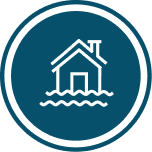 Flooding
Flooding
- Bega Valley Shire has a history of flooding. In February 1971 Bega experienced a record flood that inundated numerous properties and created significant damages resulting in two people losing their lives. Flood events have also occurred in 1983, 2010, 2011, and 2012; 27
- There are two primary river catchments in Bega Valley Shire, these being the Bega River and the Towamba River. Flooding is known to occur in all of these catchments, but in general the serious consequences of flooding are confined to the valley of the lower Bega River. Flooding can also occur at and around the townships including Merimbula, Pambula, Eden and Towamba. Flooding on other rivers and creeks within the council area occurs similarly to the Bega and Brogo Rivers however with shorter warning times; 28
- Council has undertaken several flood studies to better understand current and future anticipated flood behaviour in the various river catchments and sub-catchments and their floodplains located within Bega Valley Shire, including:
- Bega, Brogo Rivers Flood Study 2014 (prepared by SMEC); 29
- Merimbula and Back Lake Flood Study 2017 (prepared by Cardno); 30
- Eden, Twofold Bay and Towamba River Flood Study 2020 (prepared by Rhelm and Baird Innovation Engineerd); 31
- Pambula River, Pambula Lake and Yowaka River Flood Study 2021 (prepared by Catchment Simulation Solutions); 32
- Bega and Brogo Rivers Floodplain Risk Management Study and Plan 2018 (prepared by Cardno); 33 and
- Merimbula Lake and Back Lake Floodplain Risk Management Study and Plan 2018 (prepared by Cardno). 34
- To better improve response time, Council engaged Stantec to prepare a scoping and a feasibility study for a Total Flood Warning System (TFWS) for the Bega and Brogo River catchments and comprises the first part of delivering a TFWS to the community.
- Based on potential event probability as provided by the Risk Frontiers (2021), annual average loss of residential, commercial and industrial buildings due to flood is estimated at 57 per cent. This accounts for low probability but high-cost consequence of flood activity.
Actions taken or proposed
Bega Valley Shire Council has committed to undertaking the following actions in their Local Strategic Planning Statement (some of which have been completed):
- Identify gaps and/or limitations in flood and coastal hazards data and develop flood risk management plans to address identified gaps and/or limitations;
- Complete Pambula / Yowaka Rivers Flood Study and Wolumla Creek Flood Study (completed);
- Develop adaptation and hazard response plans for communities subject to high natural hazards; and
- Review planning controls for flood planning and sea level rise for new developments. 35
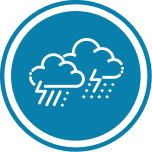 Severe storm
Severe storm
- Severe storms in NSW are often associated with East Coast Lows (ECL). ECL events are extreme weather systems that occur in South-East Australia, bringing extreme winds, rain, waves and elevated coastal water levels. In June 2016, an ECL caused significant damage to infrastructure within the Bega Valley Shire with the cost to repair and replace damaged infrastructure in excess of $2 million.
- Based on potential event probability as provided by provided by Risk Frontiers, annual average loss of residential, commercial and industrial buildings due to hail is estimated at 21 per cent. This accounts for low probability but high-cost consequence of hail activity.
Note: for the purposes of this report, cyclone was not commented on.
Actions taken or proposed
Bega Valley Shire Council has committed to undertaking the following actions in their Local Strategic Planning Statement (some of which have been completed):
- Develop adaptation and hazard response plans for communities subject to high natural hazards.36
 Storm tide inundation and erosion
Storm tide inundation and erosion
- Storm tides are known to occur in the Shire causing inundation along the lower estuary areas and beaches. These events are commonly associated with east coast lows;
- Significant erosion events have also been associated with these events (such as May-June 1974 event) which eroded metres of sand from several beaches in the Shire and impacted private infrastructure; 37 and
- In June 2016, the region was impacted by the most significant coastal storm recorded in almost 40 years, causing significant damage to infrastructure (including the historic Tathra wharf) and local beaches. 38
Actions taken or proposed
Bega Valley Shire Council has committed to undertaking the following actions in their Local Strategic Planning Statement:
- Develop adaptation and hazard response plans for communities subject to high natural hazards/
 Fire (bushfire and grassfire)
Fire (bushfire and grassfire)
- Bush fires have a range of potential impacts across the built, social, economic and natural environments. The majority of Bega Valley Shire is bushfire prone due to seventy percent of the Shire being forested and much of the remainder being grassland. Many population centres have a large urban/bushland interface, increasing exposure to bushfire; 39
- In 2019, the Badja Forest Road bushfire destroyed 301,500 hectares between Bega and Moruya. Over four hundred homes were destroyed, and six lives were lost in the Bega Valley; 40
- In 2018, Tathra was heavily impacted by the Reedy Swamp bushfire that burnt over 1,250 hectares of farmland and forest reserves. The fire destroyed 65 homes and buildings and 70 caravans/cabins; 41
- The frequency of dangerous bushfire weather days and the magnitude of bushfire weather extremes will increase in the Shire;
- Grassfires can become common on hot days and heavy winds; and
- Based on potential event probability, annual average loss of residential, commercial and industrial buildings due to bushfire is estimated at 15 per cent. This accounts for low probability but high-cost consequence of bushfire activity.
Actions taken or proposed
- Review the findings of the Royal Commission and NSW Independent Bushfire Inquiry and consider implications for land use planning and planning controls;
- Develop adaptation and hazard response plans for communities subject to high natural hazards; and
- Formalise publicly maintained bushfire Asset Protection Zones to enable use by future adjoining development.
Since the release of the Resilience Blueprint, the State Disaster Mitigation Plan (SDMP) was implemented in 2024. In addition to the above hazards, the SDMP generally covered the following:
 Landslide
Landslide
- Landslide can be triggered by severe weather events (e.g. heavy rainfall) or human activities (vegetation removal, overgrazing, slope modification, etc.).42
- Areas of Landslide Risk Land are mapped throughout Bega Valley Shire identified as ‘Constrained land’ which applies to select rural and rural-residential locations throughout the Shire.
Actions taken or proposed
- No actions have been taken or proposed to address landslide risks within the Shire.
 Heatwave
Heatwave
- Heatwaves occur when the maximum and minimum temperatures are unusually hot over 3 days, based on the area’s regular conditions. Severe heatwaves can impact vulnerable populations (e.g. aged over 65, pregnant women, people with health conditions). Extreme heatwaves can have widespread health impacts on anyone unable to take precautions to keep cool whilst also impact infrastructure43.
- Heatwaves events are known to impact Bega Valley Shire.
Actions taken or proposed
- As part of Council’s Climate Resilient Strategy, Council have commuted to creating places of cool refuge for various communities in the Shire. 44
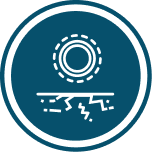 Tsunami
Tsunami
- Tsunami’s can be generated by a number of causes, however, undersea earthquakes are the most likely to generate such an event in NSW. Tsunami waves can run up beyond the high tide mark causing significant damage to coastal areas.45
Actions taken or proposed
- Bega Valley Shire have completed the local EMPLAN, within it identifies Tsunamis as a risk affecting the Shire and have included response actions should such an event occur.
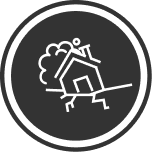 Earthquake
Earthquake
- The LGA has a low earthquake exposure, however it has experienced minor earthquakes in the past;
- Based on potential event probability, annual average loss of residential, commercial and industrial buildings due to earthquakes is estimated at 7 per cent. This accounts for low probability but high cost consequence of earthquake activity.
Actions taken or proposed
Due to low exposure within the LGA, no actions have been taken or proposed to address earthquake risk. Earthquake is however listed in the local EMPLAN as a risk.
Climate Change Data Summary

Heatwave – measured by number of days with temperatures greater than 35°C
Heatwaves are a critical climate hazard affecting health, infrastructure, and ecosystems. Heatwave risk can be measured by tracking the number of days per year with maximum temperatures exceeding 35°C. This analysis, undertaken by Risk Frontiers in 2021, drew on 20-year averages from historical climate reanalysis data and future climate model projections under a ‘medium’ emissions scenario, represented by RCP4.5 (see Figure 1 below).
Figure 1: Frequency of days per year with temperature greater than 35 Celsius Degrees
(Values are 20-year averages for present day climate and change for future climate under the RCP4.5 scenario)
The data highlights how the frequency and seasonality of high-temperature events are expected to shift over time in the LGA, informing the need for climate adaptation in infrastructure, health, and planning decisions.
Key findings:
- the magnitude of temperature extremes will increase in Bega Valley;
- largest increases in heatwave and high temperature extremes will be seen during the summer months; and
- high temperature extremes will also occur more frequently during spring and autumn.
Drought – measured by Keetch-Byram Drought Index, soil moisture and annual precipitation
Drought is a complex hazard influenced by temperature, rainfall, and how water is retained in the landscape. To assess how drought conditions are projected to change in the LGA, this analysis undertaken by Risk Frontiers in 2021 used three key climate indicators:
- Keetch-Byram Drought Index (KBDI) – a widely used index that estimates how dry the landscape is based on temperature and rainfall. It also reflects the flammability of surface fuels and is commonly used for fire management (see Figure 2 below);
- Soil moisture percentiles – a direct measure of how much water is retained in the soil compared to long-term conditions. Soil moisture is essential for agriculture, vegetation health, and ecosystem resilience (see Figure 3 below); and
- Total annual precipitation – tracks overall rainfall trends, which are a key input for drought but must be considered alongside evaporation and temperature to understand drought risk fully (see Figure 4 below).
Figure 2: Annual mean Keetch-Byram Drought Index (KBDI) drought index value normalised on a scale of 0-10, where 10 is the maximum drought possible
(Values are 20-year averages for present day climate and change for future climate under the RCP4.5 scenario)
Figure 3: Annual mean soil moisture percentiles; values are calculated relative to present day climate, hence the 50% values for present day. Low values at 2070 are indicative of a drying landscape
(Values are 20-year averages for present day climate and change for future climate under the RCP4.5 scenario)
(Values are 20-year averages for present day climate and change for future climate under the RCP4.5 scenario)
These indicators are derived from climate model simulations using 20-year averages for present-day and future scenarios under RCP4.5. Together, they provide a fuller picture of both short-term and long-term drought potential, capturing the interplay between rainfall, heat, and water retention in the landscape.
Key Findings:
- By 2070 the magnitude of drought will increase across the Shire as soil moisture declines by 2070, with the greatest impact during occurring the winter and spring; and
- changes in total annual rainfall are less than the projected changes in soil moisture and drought, suggesting that the increase in drought is being driven primarily by increasing temperatures and their effect on evapotranspiration.
Bush and grassfire – measured by the annual maximum Forest Fire Danger Index (FFDI)
Bushfires and grassfires are among the most dangerous and disruptive climate-related hazards in South-East NSW Region. The annual maximum Forest Fire Danger Index (FFDI) is the nationally recognised measure for assessing bushfire danger and is widely used by emergency services to guide fire warnings, restrictions, and preparedness. FFDI is a composite index that incorporates temperature, wind speed, humidity, and recent rainfall to estimate how dangerous fire weather is on a given day.
This analysis undertaken by Risk Frontiers in 2021 used 20-year averages from historical reanalysis data and future climate projections under the RCP4.5 scenario (see Figure 5 below). This indicator helps identify trends in both the severity and seasonal timing of fire weather across the LGA.
Figure 5: Magnitude of bushfire weather severity as represented by the annual maximum FFDI

Bush and grassfire – measured by the annual maximum Forest Fire Danger Index (FFDI)
(Values are 20-year averages for present day climate and change for future climate under the RCP4.5 scenario)
Key Findings:
- The frequency of dangerous bushfire weather days and the magnitude of bushfire weather extremes will increase in the Shire; and
- the largest changes for bushfire weather across southeast Australia are expected to be occurring during the spring, with a projected earlier onset of the bushfire season under a warmer climate.
Extreme rainfall and flooding – measured by daily precipitation over 30mm
Flooding poses a significant hazard to infrastructure, communities, and emergency services. This analysis uses the frequency of very heavy rainfall days (daily rainfall greater than 30mm) as an indicator of flood risk. This threshold (i.e., days with more than 30mm of rain often) is a recognised benchmark in climate and hydrological studies to identify rainfall events that can overwhelm stormwater systems, trigger flash flooding, and lead to significant overland flow.
Projections done by Risk Frontiers in 2021 compared 20-year averages for present day conditions with those for 2030 and 2070 under the RCP4.5 scenario (see Figure 6 below). This helps to understand how the intensity of rainfall events changes, which is crucial for flood management, infrastructure design, and emergency planning.
(Values are 20-year averages for present day climate and change for future climate under the RCP4.5 scenario)
Key Findings:
- Under present day climate there are on average 6 very heavy rainfall days per year with highest frequency in Bega Valley, which are likely to be associated with east coast lows;
- the primary driver of year-to-year variability in rainfall will continue to be the tropical climate drivers of Indian Ocean Dipole (IOD), El Niño Southern Oscillation (ENSO) and the Inter-decadal Pacific Oscillation (IPO). Projections for Pacific climate are indicating an increase in ENSO amplitude, meaning both El Niño and La Niña events will be stronger;
- extreme rainfall events will produce higher rainfall totals due to the physical relationship between a warmer temperatures and higher atmospheric moisture capacity; and
- higher rainfall totals may lead to higher flood levels during flooding events, but the frequency of these events will not differ significantly from present.
Severe storm, wind and hail – measured by East Coast Low (ECL) days and annual windspeed
Severe storms, ranging from East Coast Lows to thunderstorms and hail events, pose a recurring hazard to communities and infrastructure. This analysis uses two key indicators to evaluate storm-related risk under a changing climate:
- frequency of East Coast Low (ECL) days – ECLs are among the most damaging storm systems affecting the region, often associated with extreme winds, heavy rainfall, large waves, and coastal erosion. Tracking their frequency is important for understanding long-term storm risks (see Figure 7 below); and
- annual maximum windspeed – is used to assess the strength of storm systems and frontal weather events that can bring down trees, damage infrastructure, and increase fire danger (see Figure 8 below).
(Values are 20-year averages for present day climate and change for future climate under the RCP4.5 scenario)
Figure 8: Annual maximum windspeed (km/hr)
(Values are averaged across each LGA and calculated as 20-year averages for present day climate and change for future climate under the RCP4.5 scenario—windspeeds at individual locations and years will be significantly higher than the averages.)
These indicators help assess changes in both the occurrence and severity of damaging weather systems.
Projections done by Risk Frontiers in 2021 were based on 20-year averages comparing present-day conditions with future scenarios for 2050 and 2070 under RCP4.5. This helps identify trends in the intensity and potential impacts of storm systems in the LGA which may influence risk planning, emergency management, and infrastructure resilience.
Key Findings:
- Under present day climate, the Shire is exposed to several types of storms, including east coast lows (ECL), extra-tropical lows, fronts, snowstorms, thunderstorms, and hailstorms;
- ECL are one of the most damaging storm types to impact the Shire. ECL frequency is expected to increase slightly under future climate which is consistent with an expectation of increased large scale interactions between warm and cool air masses as the climate warms;
- extratropical lows and associated fronts and thunderstorms can cause significant risk, especially during summertime when they are a primary cause of dangerous bushfire weather; and
- maximum annual windspeed is projected to increase across the Shire, suggesting an increase in the strength of frontal systems.
Sea-level rise and coastal flooding – based on a high emissions future climate scenario
Sea-level rise is a long-term climate hazard with significant implications for coastal communities, infrastructure, and ecosystems. This analysis uses two key indicators to assess future exposure in the LGA:
- Historical and projected sea level rise based on Intergovernmental Panel on Climate Change (IPCC) 2021 model scenarios. Sea level rise projections help identify long-term trends in coastal inundation, erosion, and saltwater intrusion (see Figure 9 below);
- Modelled storm tide inundation depths, including the number of properties at risk during a 1-in-100 year storm tide event. This highlights the compounding effects of sea level rise and other extreme weather events (e.g. cyclones, east coast lows), providing a snapshot of potential flood depths and exposure for at-risk properties (see Figure 10 below); and
- While this local profile focuses primarily on RCP4.5 (i.e., medium scenario – the more likely future), sea-level rise projections are drawn from the higher emissions RCP8.5 scenario, consistent with worst-case modelling to better understand long-term risk thresholds. The findings are essential for informing coastal hazard adaptation strategies, land use planning, and community preparedness.
Figure 10: Modelled storm tide inundation depths (m) for a 1-100 year event based on G-NAF addresses including SLR estimates
Key Findings:
- Sea levels are currently rising at a rate of ~3.7mm/year and projections are for up to 1m sea level rise by 2100 under RCP8.5;
- sea level rise impacts can be experienced during extreme events such as increased magnitude of storm tide flooding or increased coastal erosion during extreme wave events. They can also impact over longer timescales such as such as ecosystems changes and contamination of aquifers; and
- For Bega Valley and Eurobodalla there are currently 162 identified properties at risk of a one in 100-year storm tide coastal flooding event. Average exposure is 0.22m, with highest exposure (>1m) at Narooma, Tomakin, and Mossy Point. This is expected to increase to 287 exposed properties by 2030, and 989 by 2070 under RCP4.5.
NARCLiM 2.0 findings for the Bega Valley
In 2022 NARClim 2.0 climate data was publicly released – this is the most up-to-date regional climate modelling available for NSW and ACT and is used Government planning, assessments, and strategies.
Table 2 describes the anticipated future climate projections specific to the Bega Valley LGA based on NARCLiM 2.0 RCP4.5 (medium emissions) and RCP8.5 (high emissions) scenarios.
This information can be viewed through can be interactive climate change project map via https://www.climatechange.environment.nsw.gov.au/projections-map
Risk Exposure Summary
A hazard is a natural process or occurrence, a source event which has the potential to result in harm or cause loss or damage depending on exposure. The Bega Valley Local Emergency Management Committee have identified the following hazards as having risk of causing loss of life, property, utilities, services and/or the community’s ability to function within its normal capacity:
|
|
|
In 2024, the State Disaster Mitigation Plan identifies these additional 3 hazards having the same risk to life and property:
- Coastal hazard (erosion and inundation);
- Storms and cyclones; and
- Tsunami 47
The Climate modelling performed by Risk Frontiers in 2021 as part of the Resilience Blueprint found that Bega Valley Shire has:
- low/moderate flood hazard risk with 10.54% of the land within a modelled floodplain; and
- moderate/medium bush and grassfire hazard risk with a modelled annual burning probability of 0.548% (as shown in Figure 11 and 12).
Figure 11: Bega Valley Flood Hazard Index
A dark blue indicates a flood plain, the lighter colour out of it.
The flood hazard index uses a map of modelled flood plains identified by several geographical/geospatial variables including different river types, river stream order, distance to river network, land cover, soil type, average slopes in known flood areas, relative changes in elevation near rivers, and river basin characteristics.
Figure 12: Bega Valley Bush-Grass Fire Hazard Index
Life, Property, Economic and Environmental Loss Risk
Fatalities and life loss
As shown in Figure 13, the risk that is posed to life is very difficult but a reality to of natural hazards. From a human health perspective, life loss throughout the region from 1900 to 30 June 2020 has been analysed using PerilAUS, Risk Frontiers’ database of natural hazard impacts. The analysis found that in Bega Valley bushfires have resulted in the most fatalities – 15 fatalities, followed by flood (10 fatalities), hazardous surf (2 fatalities) and lightening (2 fatalities).
Despite the above, more lives have been lost as a result of the impacts of disaster events across the Shire in the days, weeks, months and years that follow. The physical and mental health toll of events is enormous. It also does not capture cascading health issues and fatalities. Data in these regards is difficult to bring together but does not change the reality of the pervasive impact of disasters.
Impact on Property and Infrastructure
Figure 14 Distribution of the Average Annual Loss (AAL) of infrastructure by hazard for Bega Valley
In terms of the risks posed to property and infrastructure, Risk Frontiers’ Natural Catastrophe loss models have been used to estimate the financial cost, or Average Annual Loss (AAL) across four key hazards in the Shire being bushfire, flood, hailstorm and earthquake. The models evaluated losses for commercial, residential and industrial properties.
Under current conditions, the overall baseline AAL for Bega Valley is approximately $7.2 million and the analysis found that riverine flooding is the most significant hazard accounting for 57% of the AAL, followed by hail (21%) as shown in Figure 14.
Future climate projections indicate that the AAL in Bega Valley will be driven by fire and flood losses. Losses are projected to increase respectively by 20% for fire and 3% for flood by 2070 under a RCP 4.5 scenario, with a total AAL of $7.6 million.
Average Annual Loss identified in the State Disaster Mitigation Plan
Additionally, the SDMP indicates that the AAL in Bega Valley Shire for built environment in 2023 consisted of the following:
- Coastal hazard (erosion and inundation) – Very Low;
- Storms – Low;
- Cyclones – Very Low; and
- Tsunami – not recorded but noted as a rare event.
Editors note: the SDMP does not include specific AAL per LGA. It is colour coded on a scale from $0m to $112m.
Environmental Loss Risk
Risks to threatened flora, fauna and ecological communities from fire and flood were analysed using the following values:
|
|
|
The fire and flood indices were overlaid with an exposure index locating threatened flora, fauna and ecosystems along with agricultural lands. The analysis found that there are:
- 28 different vulnerable animal species, of which 15 are vulnerable, 8 are endangered, and 5 are critically endangered;
- 37 different vulnerable plant species in the Shire, of which 27 are vulnerable, 9 are endangered, and 1 is critically endangered; and
- 4 different vulnerable ecological communities in the Shire, of which 3 are critically endangered and 1 is endangered.
The analysis also showed 77.89% of the Shire to be the natural environment (43.19% of which is protected), 13.50% devoted to agriculture and farming and the remaining 8.61% is developed built environment.
Overall, the total maximum above ground biomass (indicating the potential vegetation density the LGA could support) is moderate/medium with 13,413 tonnes of dry matter over the LGA. This means that the environment exposure in the Bega Valley is moderate/medium as shown on Figure 15. This exposure index aligns with the ecological community index which shows moderate exposure of the endangered ecological communities west of the Shire.
Figure 15 Bega Valley Overall Exposure Index–Risk Frontiers 2021
Agricultural Productivity
While there are no significant changes for rainfall, warming temperatures will directly lead to lower overall soil moisture as seen in Table 1 in Section 3 (above). A projected decrease in soil moisture from a warmer climate may impact agricultural productivity, especially dairy operations in the Bega Valley.
There is a correlation between agricultural productivity and climate parameters representing temperature and hydroclimate variability. Productivity for dairy and beef cattle operations tends to be higher during years that are wetter, retained soil moisture and low risk of drought. This correlation is particularly apparent for dairy operations, but a similar, yet weaker correlation can be seen for beef cattle operations as shown in Figure 16.
Vulnerability and Capacity
Resilience is generally regarded as a function of the intersection of relative exposure, social vulnerability and community capacity:
- Relative exposure is a function of hazard, describing the frequency and magnitude of natural hazard events and capturing the compounding effect of multiple hazards (fire and flood for this analysis);
- Physical exposure of a community is determined such that the quantum of exposed people, buildings, essential facilities, industry, and agriculture can be evaluated;
- Social vulnerability is determined by examining socio-economic and demographic factors that may exacerbate or ameliorate the effects of an external threat to a person’s life, livelihood, or assets; and
- Community capacity to resist, avoid and / or adapt to a disaster and to use these abilities to create security either before or after a disaster can be determined by examining several factors.
For each of these measurement framework indicators, an index has been produced by a weighted average of each metric contributing to the category. An analysis of the measurement framework indicators for each Statistical Area 1 (SA1) across South East NSW culminates as an integrated index of resilience; Figure 17 and Figure 18 shows community resilience indices for the Bega Valley for bush-grass fires and flood.
- In the Bega Valley the mean relative exposure component of the resilience index is average for bush/grass fire and high average for flood. 2.6% of the population score low or worse for the relative exposure component of resilience to flood and 12.2% score low or worse for the relative exposure component of resilience to bush/grass fire;
- The Shire’s mean social vulnerability score is low average. 44.4% of the population score low or worse for the social vulnerability component of resilience; and
- The mean community capacity component of the resilience index is low average for bush/grass fire, and average for flood.10.1% of the population score low or worse for the community capacity component of resilience to flood and 22.3% score low or worse for the community capacity component of resilience to bush/grass fire.
Gaps in Data
While this local profile is underpinned by robust regional data and hazard modelling, several key data gaps remain that limit the precision of localised risk reduction planning:
- Community preparedness and capacity indicators: No recent community survey data exists on disaster readiness, access to emergency plans, or levels of volunteering in disaster response organisations.
- Historical event records: Detailed local records on the frequency, impacts, and recovery costs of past snow, storm, hail, and earthquake events are limited or not centralised.
- Economic disruption data: There is insufficient insight into how previous disasters have impacted the local economy, particularly small businesses, tourism, and agricultural supply chains.
- Infrastructure interdependencies: Modelling on critical infrastructure interdependencies (e.g., how flood risk to roads affects emergency access or supply deliveries) is not available at the LGA level.
- Monitoring and evaluation systems: Council currently lacks a framework to consistently track resilience outcomes over time, including climate impact monitoring and post-disaster recovery effectiveness.
- Integration of hazard overlays into planning instruments: While hazard data exists (e.g., fire and flood overlays), there is limited evidence that these are fully embedded within the Local Environmental Plan (LEP) or Development Control Plan (DCP), limiting the effectiveness of risk-informed development controls.
Where there are gaps in data, the profile will identify and link these to the decision guide
Reference
- NSW Department of Primary Industries and Regional Development, 2025, Wagga Wagga: Our climate. Available online at https://www.dpi.nsw.gov.au/about-us/science-and-research_old/centres/wagga/our-climate
- Wagga Wagga EMPLAN 2015
- .idcommunity, 2024, Welcome to Wagga Wagga City Council Community Profile. Available online at https://profile.id.com.au/wagga-wagga/
- .idcommunity, 2021, Wagga Wagga City Population and dwellings. Available online at https://profile.id.com.au/wagga-wagga/population
- .idcommunity, 2021, Wagga Wagga City Key statistics. Available online at https://profile.id.com.au/wagga-wagga/first-nations-keystatistics
- .idcommunity, 2021, Wagga Wagga City Population and dwellings. Available online at https://profile.id.com.au/wagga-wagga/population
- .idcommunity, 2021, Wagga Wagga City Five year age groups. Available online at https://profile.id.com.au/wagga-wagga/five-year-age-groups
- Ibid
- .idcommunity, 2021, Wagga Wagga City Need for assistance. Available online at https://profile.id.com.au/wagga-wagga/assistance
- .idcommunity, 2021, Wagga Wagga City Language used at home. Available online at https://profile.id.com.au/wagga-wagga/language
- Ibid
- City of Wagga Wagga, 2025, Economic Development Study. Available online at https://wagga.nsw.gov.au/business-investment/investing-in-wagga/studies-and-surveys
- .idcommunity, 2023, Wagga Wagga City Value added. Available online at https://economy.id.com.au/wagga-wagga/value-add-by-industry
- Ibid
- .idcommunity, 2023, Wagga Wagga City Employment by industry (Total). Available online at https://economy.id.com.au/wagga-wagga/employment-by-industry
- .idcommuntiy, 2023, Wagga Wagga City Worker productivity. Available online at https://economy.id.com.au/wagga-wagga/worker-productivity-by-industry
- .idcommunity, 2023, Wagga Wagga City Gross Regional Product. Available online at https://economy.id.com.au/wagga-wagga/gross-regional-product
- Wagga Wagga EMPLAN 2015
- Wagga Wagga EMPLAN 2015
- .idcommunity 2022
- .idcommunity 2022
- City of Wagga Wagga, 2025, Councillors. Available online at https://wagga.nsw.gov.au/the-council/about-council/councillors
- City of Wagga Wagga, 2021, Local Strategic Planning Statement. Available online at https://wagga.nsw.gov.au/the-council/planning-and-reporting/community-planning/current-community-plans/lsps
- Ibid
- WMA Water, 2021 WAGGA WAGGA MAJOR OVERLAND FLOW FLOODPLAIN RISK MANAGEMENT STUDY AND PLAN. Available online at https://wagga.nsw.gov.au/imagesfiles/documents/services/flood-management-studies/2021-wagga-wagga-major-overland-flow-floodplain-risk-management-study-and-plan/MOFFRMS_FINAL_WEB.pdf
- Ibid
- State Emergency Service, 2025, Local Flood Insights: Murrumbidgee River. Available online at https://storymaps.arcgis.com/stories/50dbc33dddcb444b9e3c526342cfc32d
- City of Wagga Wagga, 2021, Local Strategic Planning Statement. Available online at https://wagga.nsw.gov.au/the-council/planning-and-reporting/community-planning/current-community-plans/lsps
- NSW Reconstruction Authority, 2024, State Disaster Mitigation Plan. Available online at https://www.nsw.gov.au/sites/default/files/noindex/2024-02/State_Disaster_Mitigation_Plan_Full_Version_0.pdf
- Region Riverina, 2025. Four injured, trees down and power out after wild weather whips through Wagga. Available online at https://regionriverina.com.au/four-injured-trees-down-and-power-out-after-wild-weather-whips-through-wagga/80703/
- City of Wagga Wagga Council News, 2025, Council’s storm clean-up efforts clearing our nature strips. Available online at https://news.wagga.nsw.gov.au/news-articles/2025/january/storm-clean-up-efforts-clearing-our-nature-strips
- New South Wales Government, 2024, Communities in Wagga Wagga urged to Get Ready for fire scenario. Available online at https://www.nsw.gov.au/media-releases/get-ready-for-fire-season
- City of Wagga Wagga, 2021, Local Strategic Planning Statement. Available online at https://wagga.nsw.gov.au/the-council/planning-and-reporting/community-planning/current-community-plans/lsps
- News.com.au, 2024, Major power stations ‘unavailable’ as heatwave worsens in NSW. Available online at https://www.news.com.au/technology/environment/power-outages-threaten-millions-as-heatwave-grips-parts-of-australia/news-story/98f69c08e7bd4fb73b286e5185c14dea
- ABC News, 2024, Hottest summer weather in five years predicted for coming days as heatwave engulfs half of Australia. Available online at https://www.abc.net.au/news/2024-12-14/heatwave-half-australia-hottest-summer-weather-in-five-years/104723462
- South Eastern Regional Emergency Management Committee, 2021, South Eastern Emergency Management Plan’ (updated October 2023). Available online at https://www.nsw.gov.au/sites/default/files/noindex/2023-10/South_East_Region_EMPLAN_v2.1.pdf
- NSW Reconstruction Authority, 2024, State Disaster Mitigation Plan 2024-2026. Available online https://www.nsw.gov.au/sites/default/files/noindex/2024-02/State_Disaster_Mitigation_Plan_Full_Version_0.pdf






























